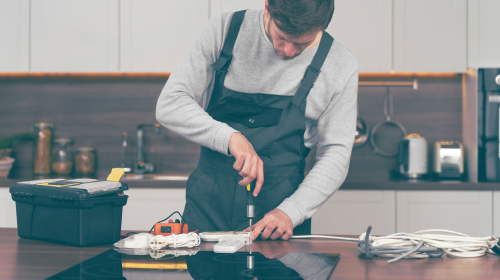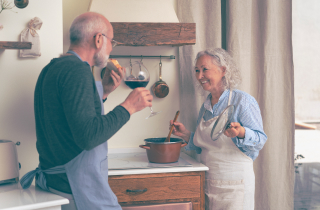Kitchen Safety for the Elderly: Essential Tips for a Secure Cooking Environment
The kitchen is often considered the heart of the home, a place where meals are prepared and memories are shared. However, for older adults, this space can present a range of hazards if not properly adapted to their changing physical abilities. From sharp utensils to slippery floors and hot surfaces, the risks associated with kitchen tasks increase with age. Implementing kitchen safety for the elderly is crucial to ensuring a safe and functional environment that allows seniors to maintain their independence while minimizing risks.
Our certified HHA provide a guide that explores kitchen safety tips for seniors, outlines strategies for avoiding injuries in the kitchen for the elderly, and discusses senior kitchen modifications that can enhance overall safety.
Common Kitchen Hazards for Seniors
Aging brings natural physical changes, such as reduced vision, decreased muscle strength, and slower reflexes, all of which can contribute to an increased risk of kitchen accidents. Some of the most common hazards include:
- Slippery floors – Spills from liquids, grease, or food can lead to falls.
- Sharp objects – Knives, graters, and other kitchen tools can cause cuts if not handled properly.
- Hot surfaces – Stovetops, ovens, and boiling liquids pose a burn risk.
- Poor lighting – Insufficient lighting can make it difficult to see spills, obstacles, or small labels on kitchen appliances.
- Inaccessible storage – Reaching for high or low cabinets can lead to strain or falls.
By recognizing these potential dangers, caregivers and family members can implement proactive senior kitchen modifications to create a safer and more accessible cooking space.

Kitchen Safety Tips for Seniors
Making small yet effective changes in the kitchen can significantly prevent kitchen accidents for seniors. Here are key strategies to enhance safety:
- Improve Accessibility
- Keep frequently used items within easy reach to prevent unnecessary bending or climbing.
- Install pull-out shelves and lazy Susans to make storage more accessible.
- Use easy-grip utensils and ergonomic kitchen tools for improved handling.
- Reduce Fall Risks
- Place non-slip mats near sinks and cooking areas to provide stability.
- Clean up spills immediately to prevent slipping.
- Ensure the kitchen floor is free from obstacles such as rugs, cords, or clutter.
- Enhance Fire Safety
- Use an automatic shut-off feature on stovetops and ovens to reduce fire hazards.
- Keep a fire extinguisher within reach and ensure seniors know how to use it.
- Avoid loose-fitting clothing while cooking, as fabric can easily catch fire.
- Improve Lighting and Visibility
- Install bright LED lighting under cabinets to illuminate workspaces.
- Use contrast-colored kitchen tools and plates to help those with vision impairments.
- Label essential items clearly with large, easy-to-read fonts.
- Ensure Safe Cooking Practices
- Opt for safe cooking for elderly individuals by using slow cookers or induction cooktops that reduce the risk of open flames.
- Use lightweight pots and pans with two handles for better grip and control.
- Encourage seated food preparation by using a sturdy chair or stool at the counter.
Elderly Kitchen Aids to Improve Safety
There are numerous elderly kitchen aids designed to make cooking safer and more convenient. Some useful options include:
- Electric can openers – Reduce the effort needed to open cans.
- Jar openers with rubber grips – Help seniors with arthritis or reduced hand strength.
- Anti-scald faucet attachments – Prevent accidental burns from hot water.
- Voice-activated or large-button kitchen appliances – Make operation easier for those with vision or dexterity impairments.
Final Thoughts
A well-designed, senior-friendly kitchen can significantly enhance an elderly individual’s confidence and independence while reducing potential hazards. By implementing kitchen safety tips for seniors and investing in senior kitchen modifications, families can create an environment that promotes both safety and ease of use.
At Angel Care Inc. NY, we understand the importance of adapting living spaces to support aging individuals. Whether through home care assistance, meal preparation, or safety evaluations, we are dedicated to ensuring that seniors can enjoy a secure and comfortable home environment.

As individuals age, maintaining independence and mobility becomes a priority, yet it often presents challenges. Whether due to age-related conditions, injuries, or chronic ailments, seniors may require assistive devices to continue their daily activities safely and comfortably. Choosing mobility aid for the elderly requires thoughtful consideration of several factors, including personal needs, lifestyle, and the level of support required. This guide will help navigate the process, offering essential insights into the best mobility aids for seniors and providing tips for selecting transportation for the elderly that align with their unique circumstances. Understanding Mobility Challenges in Seniors Mobility limitations among seniors arise from various conditions, such as arthritis, osteoporosis, Parkinson’s disease, or post-surgical recovery. The right mobility solutions for elderly individuals can significantly enhance their quality of life by preventing falls, reducing fatigue, and promoting confidence in movement. Selecting the appropriate device depends on the degree of assistance needed—whether for minor balance support or full weight-bearing assistance. Types of Mobility Aids for Seniors There is a wide array of senior mobility products designed to cater to different mobility levels. Here are some of the most common options: Canes and Walking Sticks – Ideal for those who require minimal support, canes enhance balance while walking. They come in various forms, including standard canes, quad canes for additional stability, and foldable designs for easy transport. Walkers – Providing more stability than canes, walkers are suitable for individuals who need extra support when moving. They range from standard frame walkers to rollators equipped with wheels and brakes for added convenience. Wheelchairs – For those with significant mobility impairments, wheelchairs—both manual and electric—offer enhanced movement capabilities. They can be self-propelled or pushed by a caregiver, depending on the individual’s strength and needs. Mobility Scooters – A practical solution for seniors who can no longer walk long distances, mobility scooters provide freedom for outdoor activities, shopping, and social engagements. Stair Lifts and Home Modifications – While not a traditional elderly walking aid, installing stair lifts, grab bars, and ramps can make movement within the home significantly easier for seniors with mobility concerns. Factors to Consider When Selecting a Mobility Aid With numerous assistive devices for seniors available, selecting the right one requires careful evaluation. Key aspects to consider include: Level of Support Needed – A senior requiring minor balance assistance may find a cane sufficient, while someone with more significant challenges may need a walker or wheelchair. Lifestyle and Environment – For active seniors who frequently travel, foldable canes or lightweight walkers may be more suitable, whereas those who remain at home may benefit from more substantial aids. Comfort and Adjustability – Ergonomic grips, adjustable heights, and padded seats contribute to long-term comfort and usability. Ease of Use – Mobility aids should be intuitive and easy to maneuver, minimizing strain on the user. Safety Features – Brakes, anti-slip grips, and sturdy frames enhance the security and stability of the device. The Importance of Professional Guidance Selecting mobility solutions for elderly individuals should not be a guesswork process. Consulting with healthcare professionals, physical therapists, or occupational therapists ensures that the chosen aid aligns with the user’s needs and physical abilities. They can also provide guidance on proper usage to prevent falls or injuries. Final Thoughts Finding the right senior mobility products is essential for enhancing independence, reducing fall risks, and improving overall well-being. By evaluating individual needs and considering tips for selecting transportation for the elderly, families can help their loved ones regain confidence in their movement and maintain an active lifestyle. At Angel Care Inc. home care services, we understand the importance of mobility in maintaining independence and dignity. Whether assisting with mobility aid selection or providing compassionate home care services, our mission is to support seniors in leading fulfilling lives with the right resources and guidance.

Veterans who have served their country deserve not only recognition but also access to high-quality healthcare and support services that cater to their specific needs. As they age or face health challenges, home care services for veterans become a crucial component of ensuring their well-being, comfort, and independence. However, navigating the array of veterans home health care benefits and understanding VA home care for elderly individuals can be overwhelming. This guide aims to clarify the available options, eligibility requirements, and factors to consider when selecting the best veterans home care assistance to ensure they receive the highest standard of care in a setting that respects their dignity and sacrifices. Understanding Home Care Services for Veterans In-home care for veterans is designed to provide personalized assistance, allowing former service members to remain in their own homes while receiving the support they need. These services can range from basic help with daily activities, such as meal preparation and mobility support, to more advanced medical care, including skilled nursing and rehabilitation. Depending on the level of care required, veterans may qualify for long-term care for veterans, which provides ongoing assistance tailored to their medical conditions, disabilities, or age-related needs. Many home care agencies for veterans work in partnership with the U.S. Department of Veterans Affairs (VA) to offer comprehensive solutions. Veterans Home Care Eligibility: Who Qualifies? Before choosing a home care provider, it is essential to determine veterans home care eligibility. The VA offers various programs to assist eligible veterans, which are often based on factors such as: Service-related disabilities – Veterans with service-connected disabilities may qualify for extended home care services. Income level – Some VA programs are need-based, considering financial circumstances. Age and overall health status – Senior veterans with chronic conditions or mobility limitations may be eligible for specific in-home care services. VA health care enrollment – Veterans must typically be enrolled in the VA health system to access benefits. Each case is evaluated individually, so it is advisable to consult a home care agency for veterans or a VA representative to explore the most suitable options. Types of Home Care Services Available for Veterans The VA and private home care agencies for veterans offer a wide range of services, ensuring that individuals receive the appropriate level of care based on their health conditions and personal needs. These services include: Personal Care Assistance Veterans who struggle with activities of daily living (ADLs) can receive non-medical assistance with: Bathing, dressing, and grooming Meal preparation and nutrition planning Mobility support and fall prevention Skilled Nursing and Medical CareFor those with chronic illnesses or post-hospitalization needs, home care may include: Medication management Wound care and rehabilitation Monitoring of chronic conditions such as diabetes or heart disease Respite Care for Family Caregivers Many veterans rely on family members for daily support, which can be physically and emotionally demanding. Respite care services offer temporary relief, ensuring that caregivers can take breaks while their loved ones receive professional assistance. Hospice and Palliative Care For veterans facing terminal illnesses, hospice care provides comfort, pain management, and emotional support, either at home or in a specialized facility. How to Choose the Right Home Care Provider for a Veteran Selecting the best home care services for veterans requires careful consideration of several factors, including: Accreditation and VA Approval Ensure that the home care agency for veterans is VA-certified or recognized by reputable healthcare organizations. This guarantees compliance with quality standards and seamless access to veterans home health care benefits. Personalized Care Plans Look for providers who offer customized care plans tailored to the veteran’s specific medical conditions, personal preferences, and lifestyle. Experienced Caregivers Caregivers should have experience working with veterans, understanding their unique challenges, including PTSD, mobility limitations, and service-related health conditions. Cost and VA Coverage Understanding the financial aspects is critical. Some veterans home care assistance programs are covered entirely by the VA, while others may require co-pays or additional funding sources. Exploring available VA home care for elderly benefits ensures that families maximize financial assistance. Final Thoughts Finding the right senior veterans home support involves evaluating available programs, eligibility requirements, and choosing a trusted provider that prioritizes compassionate and professional care. Whether a veteran requires short-term assistance or long-term care for veterans, the right home care services for veterans can significantly enhance their quality of life. At Angel Care Inc. NY, we are committed to providing exceptional in-home care for veterans, ensuring they receive the dignity, respect, and specialized attention they deserve. Our dedicated caregivers work closely with families and VA representatives to create personalized care solutions that promote health, independence, and comfort. For more information on veterans home health care benefits, contact Angel Care Inc. NY today and let us help you navigate the path to quality home care services.



